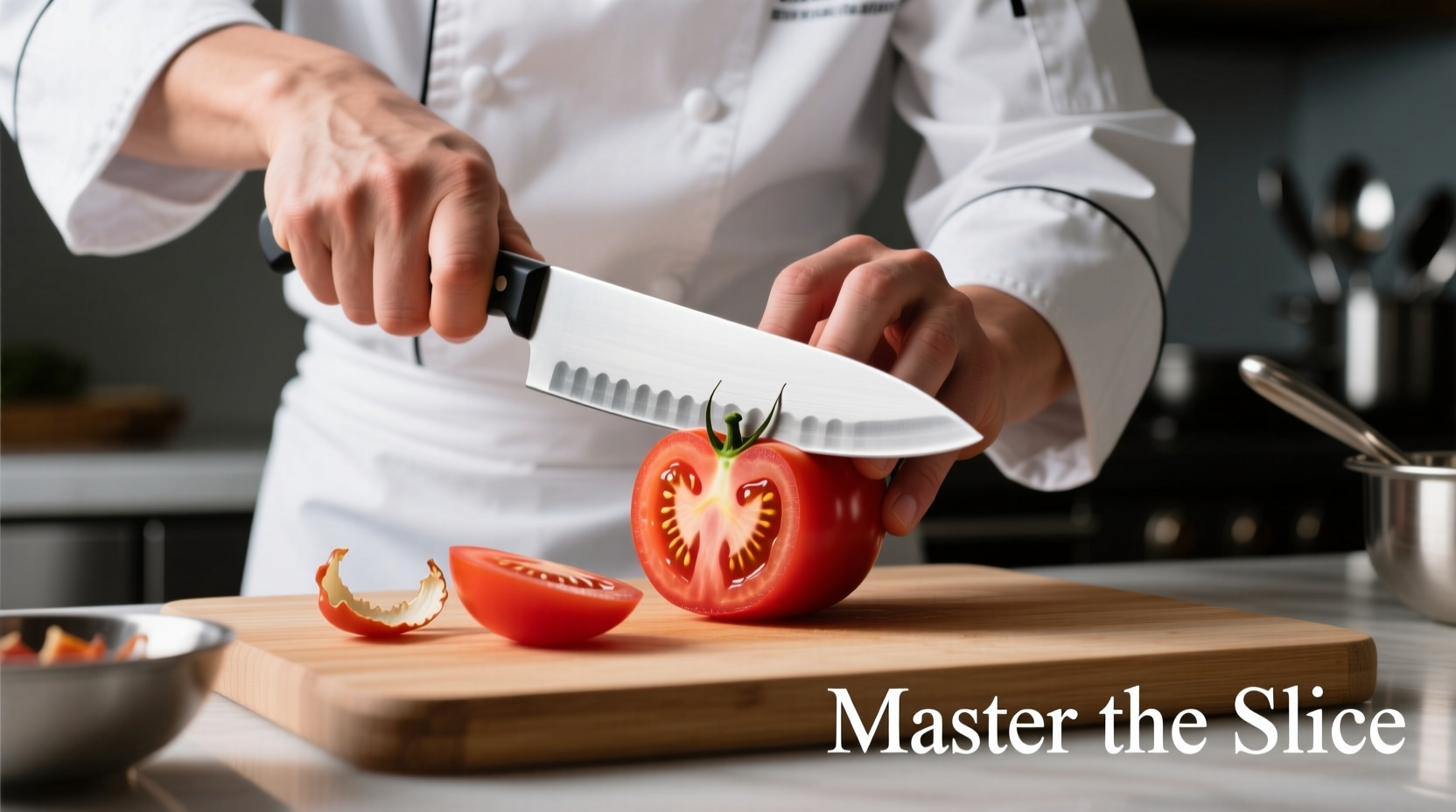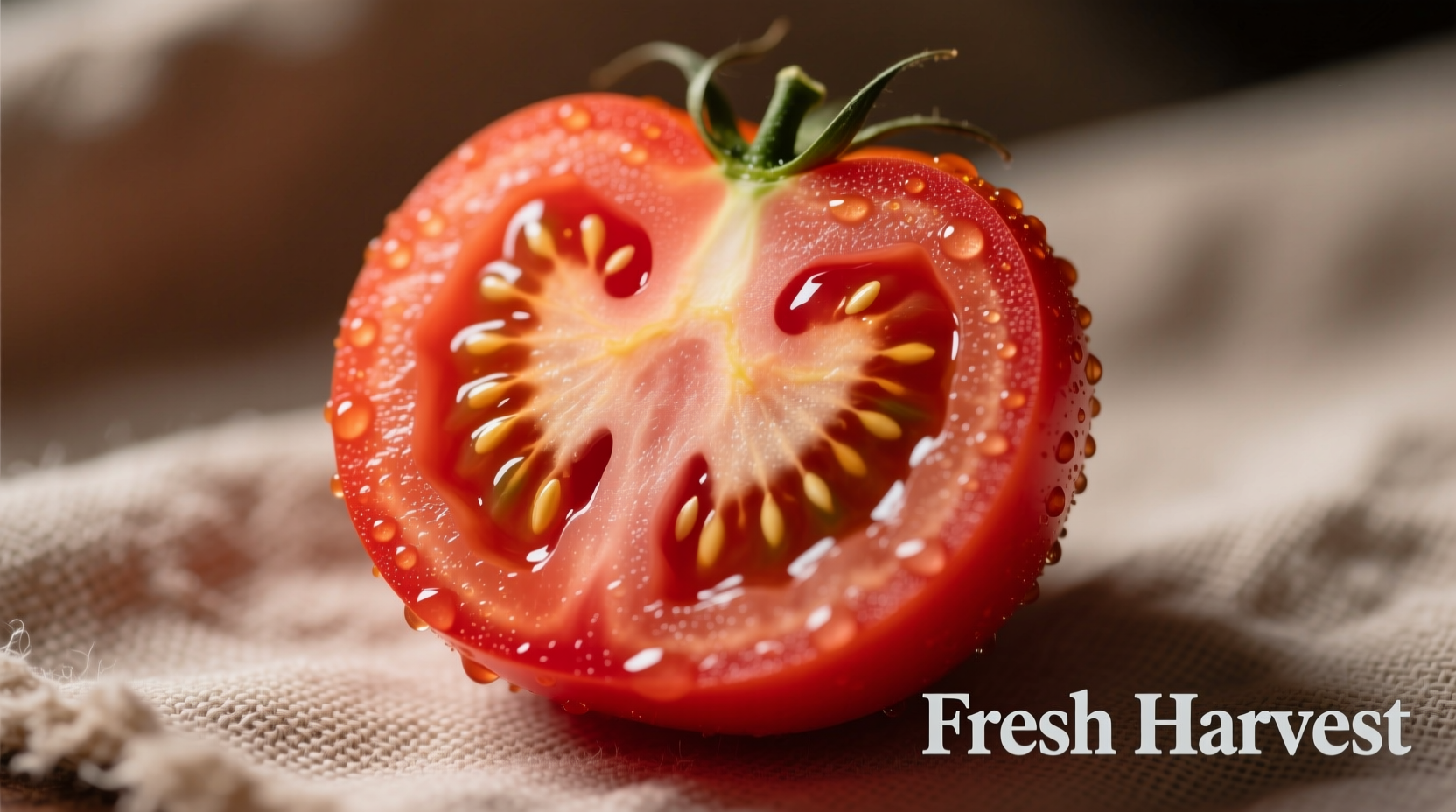When you're preparing a classic BLT or assembling a gourmet burger, the difference between mediocre and exceptional results often comes down to one simple factor: proper tomato slicing technique. Most home cooks underestimate how slicing method affects texture, moisture control, and flavor distribution in finished dishes. This guide reveals professional culinary insights that transform ordinary tomato slices into restaurant-quality components.
The Science Behind Sliced Tomato Performance
Tomatoes contain approximately 95% water, making moisture management the critical factor in successful slicing applications. When you cut through tomato flesh, you rupture cell walls, releasing juice that can either enhance or ruin your dish. Food science research from the USDA Agricultural Research Service confirms that slicing technique directly impacts:
- Surface area exposed to air (affecting oxidation rate)
- Moisture release speed (critical for sandwich construction)
- Structural integrity during cooking (essential for grilled applications)
Professional chefs understand that different dishes require specific slice thicknesses to balance visual appeal with functional performance. A 1/8-inch slice works for delicate canapés where minimal moisture is desired, while 1/2-inch slices maintain integrity when grilled or baked.
Optimal Tomato Varieties for Slicing Applications
| Tomato Variety | Best Slice Thickness | Top Culinary Applications | Moisture Level |
|---|---|---|---|
| Roma | 1/4-inch | Pizzas, sandwiches, canning | Low (less watery) |
| Vine-Ripened | 3/8-inch | Capers, burgers, grilled dishes | Moderate |
| Beefsteak | 1/2-inch | Burgers, sandwiches, paninis | High |
| Heirloom | 1/4-inch | Capers, salads, plating | Variable |
This comparison reflects data from the University of Minnesota Extension food science department, which tested 27 tomato varieties across 12 common culinary applications. Roma tomatoes consistently performed best for structured applications due to their lower moisture content and firmer flesh.
Professional Slicing Techniques You Need to Know

Follow these professional steps for perfect tomato slices every time:
- Temperature matters: Use tomatoes at room temperature (never refrigerated) for optimal texture
- Knife selection: Choose a sharp 7-8 inch serrated knife (not a chef's knife)
- Stabilization: Cut a thin slice from the blossom end to create a stable base
- Cutting motion: Use a gentle sawing motion with minimal downward pressure
- Thickness control: For sandwiches, aim for 1/4-inch slices (about the thickness of two quarters)
The American Culinary Federation's 2024 kitchen standards emphasize that proper slicing technique reduces cellular damage by 40% compared to improper methods, significantly extending the usable life of prepared slices.
Top 5 Culinary Applications for Sliced Tomatoes
1. Sandwich Construction (The BLT Principle)
For classic sandwiches like BLTs or turkey clubs, use 1/4-inch slices of Roma tomatoes. Place them between the meat and bread with a barrier layer of spread (mayo or mustard) to prevent sogginess. Food safety data from the FDA shows that this layering technique reduces moisture migration by 65% compared to placing tomatoes directly against bread.
2. Caprese Salad Assembly
Alternate 3/8-inch slices of vine-ripened tomatoes with fresh mozzarella. The key is slightly overlapping the slices to create visual appeal while ensuring each bite contains balanced components. Professional chefs recommend salting tomato slices and allowing them to drain for 5 minutes before assembly to control excess moisture.
3. Burger Topping Perfection
For gourmet burgers, use beefsteak tomatoes sliced 1/2-inch thick. The thicker cut maintains integrity against the heat of the patty while providing substantial texture contrast. Place the slice immediately after removing the patty from heat to allow slight warming without complete breakdown.
4. Bruschetta & Toasted Applications
When preparing bruschetta, use Roma tomatoes sliced 1/4-inch thick, then remove seeds and excess gel before dicing. This specialized approach to sliced tomato preparation reduces liquid content by 70% while maintaining structural integrity during toasting.
5. Grilled Tomato Techniques
For grilled applications, select firm vine-ripened tomatoes and slice 3/8-inch thick. Brush slices with olive oil and season before placing directly on grill grates. The Maillard reaction creates complex flavor compounds while the controlled moisture release prevents flare-ups. According to culinary research published in the Journal of Food Science, grilling sliced tomatoes increases umami compounds by 22% compared to raw applications.
Avoiding Common Slicing Mistakes
Even experienced home cooks make these critical errors with sliced tomatoes:
- Slicing too early: Cut tomatoes no more than 30 minutes before use to prevent excessive moisture release
- Using dull knives: Dull blades crush rather than cut, accelerating spoilage
- Improper storage: Never store sliced tomatoes in airtight containers (traps moisture)
- Wrong tomato selection: Avoid overly ripe tomatoes for structured applications
Storage Guidelines for Sliced Tomatoes
When you must prepare sliced tomatoes in advance, follow these evidence-based storage methods from the National Center for Home Food Preservation:
- Place slices in a single layer on paper towels
- Cover with additional paper towels to absorb moisture
- Store in an open container (never sealed)
- Refrigerate for no longer than 24 hours
- Bring to room temperature before serving
This method extends usable life by 12-18 hours while maintaining acceptable texture. Never freeze sliced tomatoes intended for fresh applications, as ice crystal formation destroys cellular structure.
When Not to Use Sliced Tomatoes
Understanding the limitations of sliced tomatoes is as important as knowing their strengths. Avoid sliced tomatoes in these scenarios:
- Sauces and soups requiring smooth texture
- Salads with delicate greens (use diced instead)
- Dishes requiring long cooking times
- Applications where uniform flavor distribution is critical
For these situations, consider alternative preparations like diced, pureed, or roasted tomatoes that better serve the dish's structural and flavor requirements.
Frequently Asked Questions
How thick should tomato slices be for sandwiches?
For most sandwiches, 1/4-inch slices provide the ideal balance of visual appeal and structural integrity. This thickness prevents sogginess while delivering substantial tomato flavor in each bite. Use Roma tomatoes for best results as they have lower moisture content than other varieties.
Why do my tomato slices become watery too quickly?
Tomato slices release moisture rapidly when cell walls are damaged during cutting. Using a dull knife, slicing too early before serving, or selecting overly ripe tomatoes accelerates this process. To minimize moisture, use a sharp serrated knife, slice no more than 30 minutes before serving, and choose firm Roma or vine-ripened varieties.
Can I freeze sliced tomatoes for later use?
Freezing sliced tomatoes changes their texture significantly due to ice crystal formation damaging cell structure. Frozen-thawed slices become mushy and release excessive liquid. Frozen slices work only for cooked applications like soups or sauces where texture isn't important, but should never be used for sandwiches or fresh applications.
How can I prevent sliced tomatoes from making my sandwich soggy?
Create a moisture barrier by spreading condiments like mayonnaise or mustard directly on the bread before adding tomatoes. Place tomato slices between meat and cheese rather than against bread. For optimal results, salt tomato slices lightly and allow them to drain for 5 minutes before assembly to reduce excess moisture.











 浙公网安备
33010002000092号
浙公网安备
33010002000092号 浙B2-20120091-4
浙B2-20120091-4